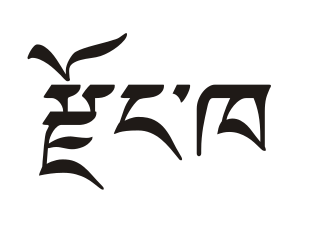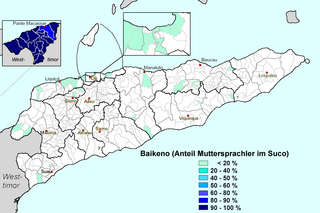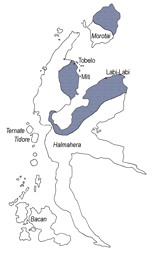Related Research Articles

Dzongkha is a Sino-Tibetan language that is the official and national language of Bhutan. It is written using the Tibetan script.
The Javanese script is one of Indonesia's traditional scripts developed on the island of Java. The script is primarily used to write the Javanese language, but in the course of its development has also been used to write several other regional languages such as Sundanese, Madurese, and Sasak; the lingua franca of the region, Malay; as well as the historical languages Kawi and Sanskrit. Javanese script was actively used by the Javanese people for writing day-to-day and literary texts from at least the mid-15th century CE until the mid-20th century CE, before its function was gradually supplanted by the Latin alphabet. Today the script is taught in DI Yogyakarta, Central Java, and the East Java Province as part of the local curriculum, but with very limited function in everyday use.
The phonology of Vietnamese features 19 consonant phonemes, with 5 additional consonant phonemes used in Vietnamese's Southern dialect, and 4 exclusive to the Northern dialect. Vietnamese also has 14 vowel nuclei, and 6 tones that are integral to the interpretation of the language. Older interpretations of Vietnamese tones differentiated between "sharp" and "heavy" entering and departing tones. This article is a technical description of the sound system of the Vietnamese language, including phonetics and phonology. Two main varieties of Vietnamese, Hanoi and Saigon, which are slightly different to each other, are described below.
Swedish has a large vowel inventory, with nine vowels distinguished in quality and to some degree in quantity, making 18 vowel phonemes in most dialects. Another notable feature is the pitch accent, a development which it shares with Norwegian. Swedish pronunciation of most consonants is similar to that of other Germanic languages.
Mongondow, or Bolaang Mongondow, is one of the Philippine languages spoken in Bolaang Mongondow Regency and neighbouring regencies of North Sulawesi (Celebes) and Gorontalo Provinces, Indonesia. With more than 200,000 speakers, it is the major language of the regency. Historically, it served as the official language of the Bolaang Mongondow Kingdom.
Stød is a suprasegmental unit of Danish phonology, which in its most common form is a kind of creaky voice (laryngealization), but it may also be realized as a glottal stop, especially in emphatic pronunciation. Some dialects of Southern Danish realize stød in a way that is more similar to the tonal word accents of Norwegian and Swedish. In much of Zealand it is regularly realized as reminiscent of a glottal stop. A probably unrelated glottal stop, with quite different distribution rules, occurs in Western Jutland and is known as the vestjysk stød. The word stød itself does not have a stød.
The Mentawai language is an Austronesian language, spoken by the Mentawai people of the Mentawai Islands, West Sumatra, Indonesia.

Uab Meto or Dawan is an Austronesian language spoken by Atoni people of West Timor. The language has a variant spoken in the East Timorese exclave of Oecussi-Ambeno, called Baikenu. Baikenu uses words derived from Portuguese, for example, obrigadu for 'thank you', instead of the Indonesian terima kasih.
Dutch phonology is similar to that of other West Germanic languages, especially Afrikaans and West Frisian.

Tobelo is a North Halmahera language spoken on the eastern Indonesian island of Halmahera and on parts of several neighboring islands. The Tobelo-speaking heartland is in the six administrative districts of Tobelo, located on the western shore of Kao Bay and forming the central part of Halmahera Utara Regency. Other Tobelo-speaking areas are the five districts of Wasile on the southern and eastern shores of Kao Bay, and the northern half of Morotai Island. The district capital, also known as Tobelo, serves as a regional commercial and administrative center and is the largest settlement on Halmahera.
The Gorontalo language is a language spoken in Gorontalo Province, Sulawesi, Indonesia by the Gorontalo people.
Galela is the second most populous Papuan language spoken west of New Guinea, with some 80,000 speakers. Its dialects are Kadai (41,000), Morotai (24,000), Kadina (10,000), and Sopi (4,000). Its closest relative is the Loloda language.
Toraja-Saʼdan is an Austronesian language spoken in South Sulawesi, Indonesia. It shares the name Taeʼ with East Toraja. Most of the Toraja language mapping was done by Dutch missionaries working in Sulawesi, such as Nicolaus Adriani and Hendrik van der Veen.
Kelon, or Klon, is a Papuan language of the western tip of Alor Island in the Alor archipelago of East Nusa Tenggara, Indonesia.
Ponosakan is an Austronesian language spoken in the vicinity of the town of Belang, North Sulawesi, Indonesia. This language is almost extinct, with only four fluent speakers left as of November 2014.

Proto-Slavic is the unattested, reconstructed proto-language of all Slavic languages. It represents Slavic speech approximately from the 2nd millennium BC through the 6th century AD. As with most other proto-languages, no attested writings have been found; scholars have reconstructed the language by applying the comparative method to all the attested Slavic languages and by taking into account other Indo-European languages.
Termanu is a Central Malayo-Polynesian language of Roti Island, off Timor, Indonesia. Speakers of Korbafo and Bokai dialects are ethnically distinct.
Daniel Anthony Overbeek was the last resident of Dutch Bengal between 1817 and 1825.

Lontara Bilang-bilang is a cipher of the Lontara script, currently used for Buginese poetry. This script uses the Eastern Arabic numerals-inspired letterform to substitute the Lontara script, as a way to hide it to the Dutch at the time. It was an adaptation to a similar ciphers of the Arabic script that has been used in South Asia around the 19th century.
Proto-Torres-Banks is the reconstructed ancestor of the seventeen languages of the Torres and Banks Islands of Vanuatu. Like all indigenous languages of Vanuatu, it belongs to the Oceanic branch of the Austronesian languages.
References
- ↑ Tabaru at Ethnologue (18th ed., 2015) (subscription required)
- ↑ Fortgens, J. (1928). "Grammatikale Aanteekeningen van het Tabaroesch; Tabaroesche Volksverhalen en Raadsels" [Grammatical Notes of Tabaru; Tabaru Folktales and Riddles]. Bijdragen tot de Taal-, Land- en Volkenkunde van Nederlandsch-Indië (in Dutch). 84 (2/3): 300–544. JSTOR 20770253. doi : 10.1163/22134379-90001497 doi : 10.1163/22134379-90001498
- ↑ Kotynski, Edward A. (1988). "Tabaru phonology and morphology". Work Papers of the Summer Institute of Linguistics, University of North Dakota. 32: 143–216. doi: 10.31356/silwp.vol32.06 .